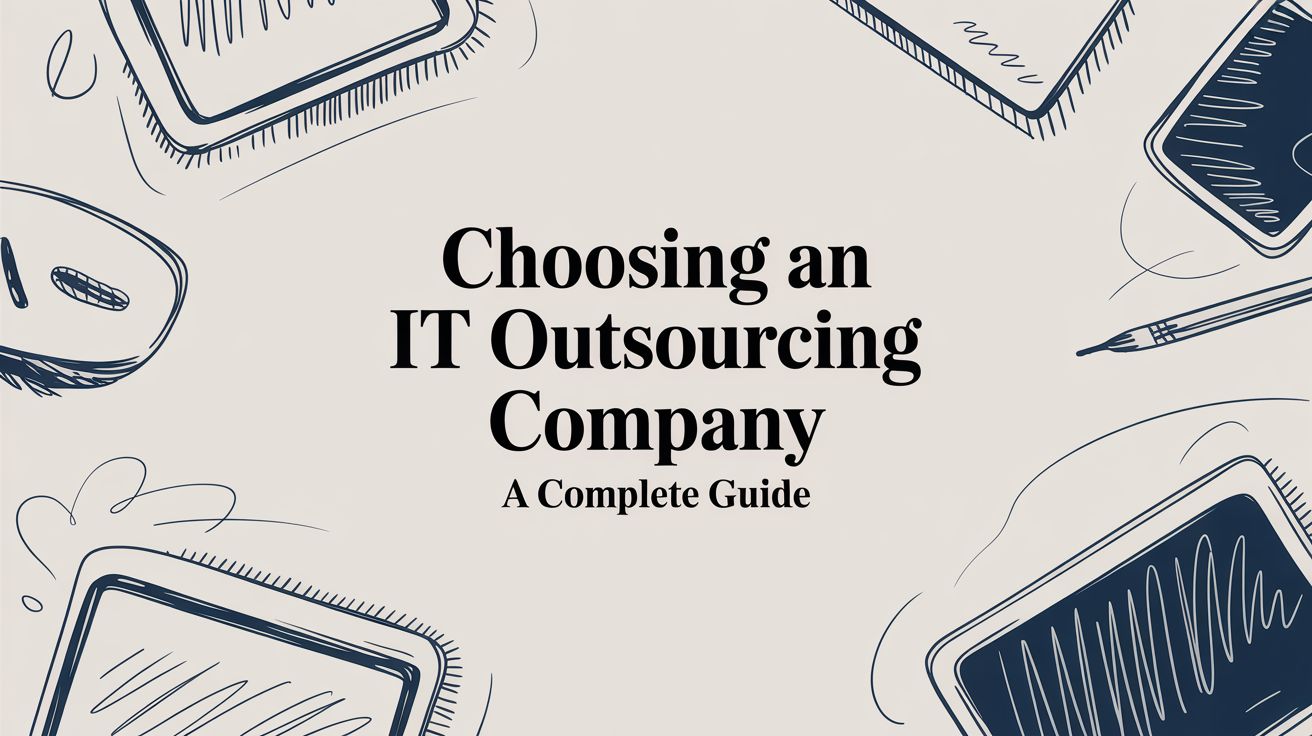
December 15, 2025
Managed IT Services for Alberta Private Career CollegesDiscover managed IT services for Alberta private career colleges. Boost security, compliance, and student success with a dedicated IT partnership.
Read Full Post%20(1).webp)
Usman Malik
Chief Executive Officer
October 31, 2025

Think of an IT outsourcing company as your strategic partner—a team of experts who manage some, or all, of your organization’s technology needs. This partnership frees up your internal team to focus on core business objectives while seasoned professionals handle complex tasks like cybersecurity, cloud management, and day-to-day support.

An IT outsourcing company is more than just a vendor; it functions as your on-demand technology department. At its core, an IT outsourcing firm provides specialized skills and services that most medium-sized businesses cannot affordably maintain in-house. It’s about gaining immediate access to a deep pool of talent without the overhead of salaries, training, and benefits.
Imagine your business is a high-performance race car. As the driver, you need to focus completely on the track ahead to win. An IT outsourcing partner is your dedicated pit crew, on call 24/7. They handle everything from engine diagnostics (network monitoring) and tyre changes (software updates) to your fuel strategy (data management). This allows you to concentrate on growth instead of trying to be both the driver and the mechanic.
One of the greatest advantages of an IT partner is the sheer breadth of specialized skills they bring to the table. A single in-house IT generalist cannot possibly master every domain, from cloud computing to cybersecurity. An outsourcing firm, in contrast, is a collective of experts.
This typically includes:
This model is a game-changer for tackling specific challenges. Instead of a long and expensive hiring process for a short-term project, you gain instant access to the exact expertise you need, right when you need it. You can explore what managed IT services are to understand the proactive support they provide in more detail.
For Canadian companies, partnering with an IT outsourcing firm is quickly becoming a key strategy for navigating a competitive market. The tech talent shortage and rising operational costs present major hurdles to growth. Outsourcing helps businesses overcome these challenges with predictable costs and a ready-made skilled workforce, allowing them to sharpen their focus on their core competencies.
This is not just a trend; the data supports it. While Canada's Information and Communications Technology (ICT) sector is a significant economic driver, the country faces a projected shortfall of 250,000 tech professionals. With the Canadian IT outsourcing market valued at approximately $13 billion, it is clear that businesses are turning to external partners to fill this critical skills gap and maintain efficiency. This strategic shift allows organizations to remain agile and competitive without getting bogged down by the complexities of modern IT management.

Deciding to work with an IT outsourcing company is an excellent first step, but not all partnerships are created equal. The key is to find a service model that aligns with your company’s daily needs, budget, and long-term goals. Without the right fit, you risk paying for services you will never use or, worse, finding yourself without support when you need it most.
Think of it like local transport. A pay-as-you-go taxi makes sense for a single trip, but leasing a car provides reliable, everyday transportation for a set monthly price. IT outsourcing works similarly, offering different models for various business situations.
Let's review the four main approaches so you can determine which one is the right fit for your organization.
The Managed IT Services model is like having a complete, dedicated IT department on your team for a flat monthly fee. This is the most proactive way to manage your technology. Your partner, known as a Managed Service Provider (MSP), assumes full responsibility for monitoring, managing, and maintaining your entire IT infrastructure.
Instead of waiting for something to go wrong, an MSP works continuously behind the scenes to prevent problems before they start. This all-in-one model covers everything from 24/7 help desk support and network monitoring to cybersecurity defence and long-term IT strategy.
Real-World Scenario: A growing Canadian e-commerce brand needs its website and systems running flawlessly around the clock, especially during major sales events. With Managed IT Services, they don't have to worry about their network being monitored for threats or performance slowdowns. They can focus on marketing and fulfilling orders, not fighting IT fires.
The Break-Fix model is the traditional, reactive approach to IT support. As the name implies, you only call for help—and pay for it—when something breaks. There is no contract, no ongoing monitoring, and no proactive work involved.
This pay-as-you-go method can appear inexpensive at first, particularly for businesses with very basic technology needs. However, the costs can quickly become unpredictable and escalate during a major outage. Furthermore, the downtime experienced while waiting for a technician can seriously impact your operations.
Staff Augmentation allows you to bring specialized talent into your in-house IT team on a temporary basis. It is the perfect solution when you have a specific project or require an expert skill that your current team lacks, but you do not want to go through the entire process of hiring a full-time employee.
For example, if you are migrating your systems to the cloud, you might bring in a cloud migration specialist for a few months to ensure the process goes smoothly. You manage them directly as part of your team, and when the project is complete, the contract ends. It provides incredible flexibility to scale your team’s skills whenever necessary.
Sometimes, you do not need ongoing management but require a dedicated team to handle a specific, one-time project. Project-Based Services, often used for tasks like cloud migrations or security audits, are designed for these exact situations.
You and the IT company agree on the project's scope, timeline, and deliverables, usually for a fixed price. The provider then manages the entire project from start to finish, delivering the final result without locking you into a long-term commitment. To see how specialized delivery can work, consider the DevOps as a Service (DaaS) model, where an external team handles the entire software delivery pipeline.
To help you see how these models compare, here’s a quick summary.
This table breaks down the four main IT outsourcing models, making it easier to identify which one aligns best with your business needs, budget, and goals.
Ultimately, the right choice depends on your company's unique situation—from its size and complexity to its plans for the future.
Entrusting your IT to an external partner is a significant move. It is not just a technical decision—it is a business one. Done correctly, it can accelerate your growth. However, proceeding without a clear-eyed view of both the advantages and disadvantages is a recipe for trouble.
To make the right choice, you need to understand the powerful benefits you can gain and the potential pitfalls you will need to navigate. Let's break down what that really looks like.
Most business leaders initially consider outsourcing to cut costs, and while that can be a benefit, the real game-changers are strategic. The right IT partner gives you a competitive edge that is difficult, if not impossible, to build on your own.
Real-World Example: We worked with a mid-sized Canadian manufacturer that was constantly battling server downtime. This wasn't just a tech problem; it was a business problem. By partnering with us, they moved to a secure cloud setup, boosted their production uptime, and gained 24/7 monitoring. The best part? It all came at a fixed monthly fee that was less than what they would have paid a single senior IT administrator.
Of course, allowing a third party to manage something as critical as your IT is not without risk. The key to a successful partnership is acknowledging these challenges and planning for them from day one. Awareness is your first line of defence.
Outsourcing is more common than you might think. A recent report found that 52.2% of Canadian companies outsourced some work in the last year to remain flexible and manage labour needs. You can explore the full findings from Statistics Canada to see the broader trend.
Even with its popularity, you need to be cautious. Here are the main risks to keep on your radar:
By weighing these factors carefully, you can make an intelligent, informed decision. The numerous benefits of IT outsourcing often far outweigh the risks, especially when you find a partner committed to transparency, communication, and robust security.
Choosing an IT partner is one of the most important technology decisions you will ever make. This is not just about hiring a vendor to fix computers; it is about bringing in a strategic ally who will protect your data, support your team, and help your business grow.
A great partnership can put your business on the fast track. A poor one can lead to security nightmares, costly downtime, and endless frustration for you and your staff.
To avoid the pitfalls, you need a clear game plan. It is time to look past the slick sales pitches and delve into what truly makes an IT outsourcing company a good fit for your specific needs. This requires a methodical approach to evaluating their skills, processes, and how well they align with your vision.
Before you even consider making a call, you need to know exactly what you are looking for. A detailed checklist is your best tool—it ensures you are evaluating every candidate using the same critical benchmarks, making your final decision objective and well-informed.
Your checklist should focus on a few key areas:
Once you have narrowed your list to a few contenders, the interview is where you separate the truly great from the merely good. The goal is to get a feel for how they think, how they act under pressure, and whether they genuinely see themselves as a partner in your success. Generic questions will only yield generic, rehearsed answers.
How a potential partner outlines their response to a crisis reveals more about them than any marketing brochure ever could. For instance, their process for handling a security breach shows everything about their preparedness, transparency, and sense of accountability.
Push beyond their sales presentation with questions that probe their operational depth. As you prepare for these conversations, reviewing this comprehensive guide to IT outsourcing development can provide a broader perspective on the entire process, including different models and cost management.
Here are some essential questions to have ready for every potential IT outsourcing company:
By taking this structured approach—starting with a checklist and moving on to insightful questions—you can confidently choose an IT partner who is not just technically skilled, but genuinely invested in helping you succeed.
Selecting the right IT partner is a huge step, but the real work begins with a smooth, well-planned handover. The transition from your in-house team or another provider to your new IT outsourcing company is a critical moment. A messy migration can cause downtime, frustrate your staff, and start the new relationship on a poor footing.
The key is a structured approach that breaks the entire process down into clear, manageable stages. This ensures nothing is missed, everyone knows what to expect, and the changeover has minimal impact on your day-to-day work. The goal is simple: to move from your current state to your new, improved IT setup without any bumps in the road.
A proven transition plan removes the guesswork and builds confidence from the start. While every company is different, the core steps of a successful migration follow a logical path, ensuring all your critical systems are handed over securely and thoroughly.
Discovery and Audit: Your new partner's first task is to listen. They will conduct a deep dive into your current IT infrastructure—your network, hardware, software, security, and more. This audit identifies what is working, what is not, and where the risks lie, creating the foundation for the entire migration strategy.
Building the Migration Plan: Once they have a clear picture of your setup, the provider will craft a detailed migration roadmap. This document outlines timelines, responsibilities, communication channels, and the specific technical steps involved. Think of it as a shared blueprint that keeps your team and theirs aligned.
Execution and Handover: This is where the action happens. It might involve moving your data to a new cloud platform, rolling out new security tools, or shifting help desk duties. A good provider will perform most of this work after hours to keep disruptions to a minimum.
Ongoing Support and Optimization: After the migration is complete, the partnership transitions into its long-term phase. This is when you will gain access to ongoing support channels, like a dedicated help desk, and they will begin the proactive monitoring and maintenance that keeps your systems running smoothly.
How do you really know if the partnership is working? A vague feeling that things are better is not enough. You need concrete metrics to hold your new partner accountable and measure the real-world value they are bringing. A great IT outsourcing company will work with you to define these Key Performance Indicators (KPIs) before the migration even begins.
These metrics need to cover both technical performance and business outcomes. This two-pronged approach ensures your technology is not just running well but is actively helping your company grow and become more efficient.
The visual below shows the high-level process of finding, vetting, and choosing the right partner to start this journey.

This straightforward process helps you move from initial research to a final decision with clarity, setting the stage for a successful handover.
Success is not just about faster computers or fewer error messages. It is about empowering your team to be more productive and giving your leadership peace of mind that your technology is secure, reliable, and aligned with your business objectives.
To track this, focus on a balanced scorecard of KPIs:
The demand for these partnerships is climbing rapidly in Canada. One report showed that the portion of IT budgets allocated to outsourcing grew by 45% in a single year, with 40% of leaders planning to invest even more in third-party assistance. You can learn more about these IT outsourcing trends to see how the market is evolving.
By establishing this framework from the outset, you build a transparent, results-focused relationship. It gives you the power to confirm that your new partner is delivering on their promises and providing measurable value from day one.
We have covered a lot of ground, and it should be clear that engaging an IT outsourcing company is not just about cutting costs. It is a strategic decision to sharpen your competitive edge. You are not just offloading tasks; you are gaining expertise that strengthens your security, smooths out operations, and frees up your team to do what they do best—drive your business forward.
So, the real question is: where do you stand right now? It is a good time to take a hard look at your current IT setup and assess whether it is helping you grow or holding you back.
Ask yourself these three questions honestly:
If you hesitated on any of those, it is likely a sign that it is time to consider a different approach. An IT outsourcing company can fill those gaps, transforming your technology from a line item expense into one of your most powerful assets.
This is not just about handing off your IT problems. It is about gaining a partner who is as invested in your success as you are. The right provider works with you to build a resilient, forward-thinking technology foundation so you are always ready for what comes next.
If you are ready to confidently answer 'yes' to those questions, our team at CloudOrbis is here to help. We believe in creating a clear roadmap that aligns directly with your unique challenges and future ambitions.
Let's start a conversation about what you need. Together, we can build a plan to strengthen your security, streamline your daily operations, and help you achieve your most ambitious goals.
Even after seeing the benefits, most business leaders still have a few practical questions before they are ready to bring on an IT partner. Getting clear, straightforward answers is the final piece of the puzzle, giving you the confidence to move forward. Let's tackle some of the most common questions we hear from Canadian businesses considering this strategic shift.
This is usually the first question on everyone's mind, but the truth is, there is no one-size-fits-all answer. The cost of IT outsourcing depends entirely on what you need and the service model that makes the most sense for your business. An experienced IT outsourcing company will not provide a generic price but will offer a few clear pricing structures designed for different needs and budgets.
Here are the most common models you will see:
That’s a completely fair question. However, the goal of a modern IT partnership is not to take control—it is to give you better control through collaboration and transparency. A healthy relationship with an IT outsourcing company is built on shared goals, not just handing over the keys and hoping for the best.
Think of it less as losing control and more as gaining a strategic advisor. Your partner handles the day-to-day technical tasks, freeing you up to focus on the big picture, armed with all the data you need to make smart decisions.
A great provider will give you regular, easy-to-understand reports on system performance, security updates, and support activity. This keeps you in the driver's seat, fully aware of what is happening without getting bogged down in the technical details.
This is a very important distinction to make. IT outsourcing is the umbrella term for hiring any third-party to handle IT tasks. It could be anything from a one-off project to ongoing support.
Managed services, on the other hand, is a specific type of outsourcing. A Managed Service Provider (MSP) takes a proactive, big-picture approach, managing your entire IT environment for a flat monthly fee. Instead of just reacting to problems as they arise, an MSP is focused on preventing them from ever happening.
For most growing Canadian businesses, partnering with an MSP is the smartest and most valuable form of outsourcing. It delivers predictable costs, stronger security, and a long-term technology roadmap that supports your growth.
At CloudOrbis Inc., we believe the right IT partner empowers you, giving you the security and efficiency needed to grow without limits. If you’re ready to see how a proactive managed services approach can transform your business, let's start a conversation about your goals.

December 15, 2025
Managed IT Services for Alberta Private Career CollegesDiscover managed IT services for Alberta private career colleges. Boost security, compliance, and student success with a dedicated IT partnership.
Read Full Post
December 15, 2025
Small business it support edmonton: A Guide for Local Business LeadersDiscover small business it support edmonton options with clear pricing, expert guidance, and efficient IT solutions for growth.
Read Full Post
December 14, 2025
Small business it support edmonton: A Guide for Local Business LeadersDiscover small business it support edmonton options with clear pricing, expert guidance, and efficient IT solutions for growth.
Read Full Post